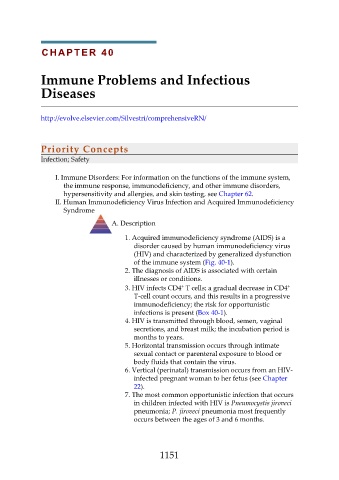Page 1151 - Saunders Comprehensive Review For NCLEX-RN
P. 1151
CHAPTER 40
Immune Problems and Infectious
Diseases
http://evolve.elsevier.com/Silvestri/comprehensiveRN/
Priority Concepts
Infection; Safety
I. Immune Disorders: For information on the functions of the immune system,
the immune response, immunodeficiency, and other immune disorders,
hypersensitivity and allergies, and skin testing, see Chapter 62.
II. Human Immunodeficiency Virus Infection and Acquired Immunodeficiency
Syndrome
A. Description
1. Acquired immunodeficiency syndrome (AIDS) is a
disorder caused by human immunodeficiency virus
(HIV) and characterized by generalized dysfunction
of the immune system (Fig. 40-1).
2. The diagnosis of AIDS is associated with certain
illnesses or conditions.
+
3. HIV infects CD4 T cells; a gradual decrease in CD4 +
T-cell count occurs, and this results in a progressive
immunodeficiency; the risk for opportunistic
infections is present (Box 40-1).
4. HIV is transmitted through blood, semen, vaginal
secretions, and breast milk; the incubation period is
months to years.
5. Horizontal transmission occurs through intimate
sexual contact or parenteral exposure to blood or
body fluids that contain the virus.
6. Vertical (perinatal) transmission occurs from an HIV-
infected pregnant woman to her fetus (see Chapter
22).
7. The most common opportunistic infection that occurs
in children infected with HIV is Pneumocystis jiroveci
pneumonia; P. jiroveci pneumonia most frequently
occurs between the ages of 3 and 6 months.
1151

